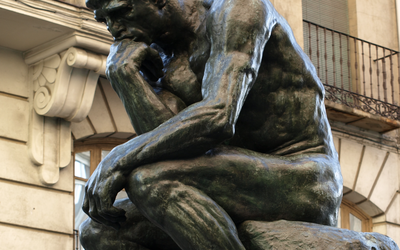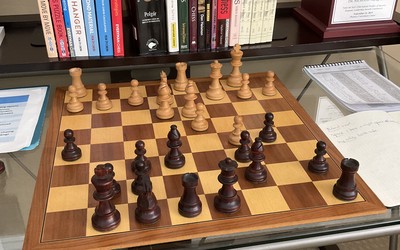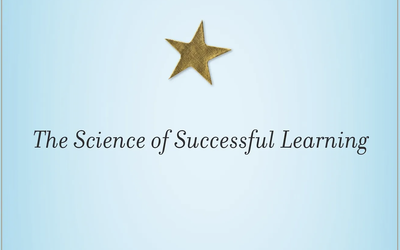
How Adults can get better at chess
What I've learned from 5 years of working on chesshttps://substackcdn.com/image/fetch/w_1456,c_limit,f_auto,q_auto:good,fl_progressive:steep/https%3A%2F%2Fsubstack-post-media.s3.amazonaws.com%2Fpublic%2Fimages%2Fdd92b7b5-bfb6-4946-acd8-1008605481d0_1485x574.png
-Mark Twain (although lots of people have been credited for this quote)
Adult chess improvement can be yours by:
- Training your brain daily to learn common chess patterns is the fastest way to get better
- Also, developing three unique chess skills of Visualization, Calculation, and Evaluation will help you find better moves
- Use them to “look ahead” 1 1/2 - 3 moves to see which resulting position is best for you
(P.S. We’ll fail a lot, it’s ok)
Allow me to explain...
Last post, I tried my best to sum up 5 years of chess work (kind of humbling actually). Today I’ll try and sum up what I’ve learned on how adults can improve in chess.
I’d love to tell you that I’ve learned some secret or single piece of knowledge that will unlock adult improvement. While for my money “Stop dropping pieces” is pretty dang close to it (easily get you up over 1300-1400), I don’t believe that sort of information exists.
Chess is a game possibly 1000+ years old but the modern version dates to the 1500’s. We’ve had geniuses come and transform the game but no one has “solved” chess yet. More books are publishedeach year on chess than any other sport. The appeal seems endless which is a little odd for a game that technically doesn’t involve any hidden information or surprises. All the information is there in front of us, if only we could see it. Of course few of us can and none of us are able to out-calculate a chess engine. What I’ve learned after 5 years is we don’t have to.
Chess at its heart is a game of timed decision making. Each subsequent move after the first one depends upon the moves preceding it. 1.e4 e5 is very different than 1.e4 c5 and so on. In that way, chess becomes sort of like a choose your own adventure bookwhere someone else gets to make every other decision. Humans it turns out are emotional first when it comes to decision making.
Emotions like fear, desire, hope, and love all guide our daily behavior even as our more sophisticated cerebral cortex does the analysis and slow thinking. Emotions arise in the limbic system of our brains, our “emotional brain” if you will. Another way of understanding emotions is they act as our “System 1” which is designed first and foremost to keep us alive. It is fast but error prone, uses heavily biased thinking, and skews toward the negative interpretation of events. Analysis is our “System 2”, based in slow thinking which is mentally taxing for the brain even as it is more accurate. Our brains greatly prefer “the easy way” as it turns out nearly 98% of daily decisions are based on System 1.
It’s important to accept that emotions are a critical element of decision making, not something that can be eliminated but something that must be leveraged. Think back to how we learned to tie a shoe. It was difficult at first, and it required all of our attention. If we struggled to pick it up, we didn’t like it and tried to avoid it (at least that’s what my daughter did). Slowly we gained the dexterity required to make those knots. Over time it became easier and easier. In fact now we don’t even have to think about it any more. That progression right there lays at the heart of how adults can get better at chess.
We cannot simply overpower chess with a big brain. We don’t work that way. Luckily there is another way. To improve we simply need to train both systems of our brain so they’re working in together as best as they can. Let me explain how I think that can be accomplished.
System 1 just needs pattern recognition, and a lot of it. It needs frequent, repeated signals to become able to “see” mate in 1 or mate in 2. This is where a daily chess work comes in so handy. Memories are like food, best when fresh and they go stale quicker than we’d like. Learning common chess patterns so well that they become second nature is one of the most consistent ways of getting better at chess. Period. There are some great products out there to helpus with that. Take this example: White to play and win (think for no more than 20 seconds)
Screen Shot 2023-03-06 at 10.07.01.png
Still, no matter how many patterns we learn we’ll still run into a position where we don’t know what to do. That’s where we need to slow down and deploy system 2. To find a good move in a new position, system 2 will require us to develop three separate skills:
Visualization is simply the ability to “see” in our minds what the board looks like after a piece or two move. This is what I learned from Step 2 Thinking Ahead but any daily practice will build it slowly. I personally think this is the entry point into calculation. (My opinion - there is no calculation without visualization, but many of us seem to neglect developing it and go straight to calculating)
Calculation is the ability predict and analyze all the possible responses your opponent has to our move(s). Another way of saying it is the ability to work all the variations possible in a position rather than just relying on intuition (aka System 1). For me calculation is by far the most important skill of the three.
Lastly is evaluation or the ability to see which side is better and why. When facing a decision on which move to make we need to know if we’re ahead, equal, or behind. Our strategy and play changes based on the evaluation. For me this is the slowest developing skill.
For example, in one my most recent game I reached this position and wasn’t sure what to do even though I was up an exchange. I’m ahead, but not yet winning. If I’m not careful the rook can get trapped. (If you’re game, try to come up with 3 possible candidate moves for Black)
Screen Shot 2023-03-06 at 10.04.40.png
To be honest with you, this is why chess is hard. Developing these three skills takes time, repeated intentional practice, and feedback. Along the way it can be easy to get discouraged even though you’re slowly getting stronger and stronger. Often we are our own worst critics, especially when the computer shows us all the “blunders” we made.
Now the good news: We don’t need to calculate like a computer, just like a human. GM Soltis wrote in his book “Studying Chess Made Easy” that we need to be able to fully evaluate at least 1 1/2 moves (and probably not much more than 3). That is our move, their move, and our response. If we can visualize those moves and see the board in our mind, we can calculate the variations and decide which of those lines are better for us.
We don’t need perfect analysis, but we do need solid work. It is critical that we see “wide” rather than deep. We need to get a sense of where the game is headed and if that’s a good place or not. It’s ok and actually normal to use emotional language here like “good” or “bad” or “scary”. But emotions must act as a trigger initiating the slow search for the actual variations possible in the position. We don’t have to know how the game will end, as long as we have a concrete grip on how the next few moves might play out.
Let’s try to sum up.
Chess is a game of timed decision making. We need to choose between moves based on which resulting position is better for us. To get better at chess we need to take 3 steps:
- Train our system 1 brain to recognize common chess patterns (our intuition)
- Develop Visualization, Calculation, and Evaluation skills ( our analysis)
- Look wide before deep. Evaluate the positions 1 1/2 - 3 moves ahead. Choose the one that you feel is better for you after analysis.
Thanks for reading. If you enjoyed it please tell a friend about this blog.
Nicholas Vasquez




